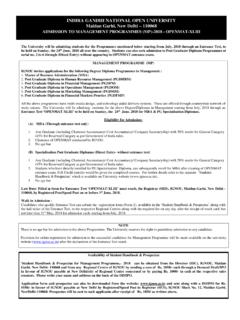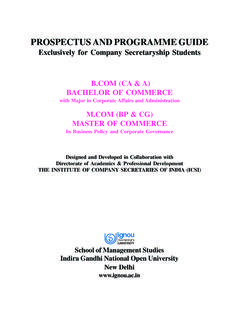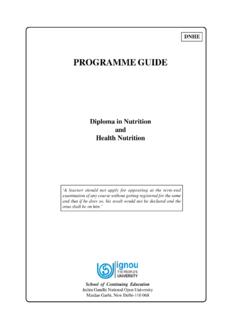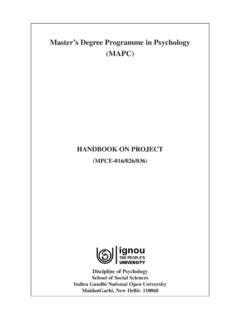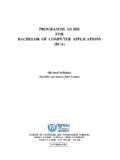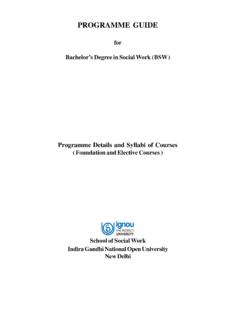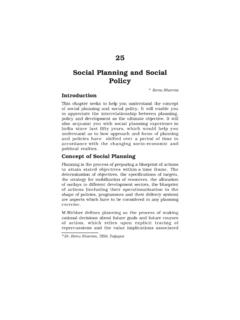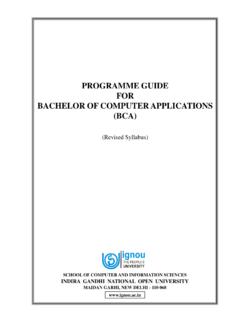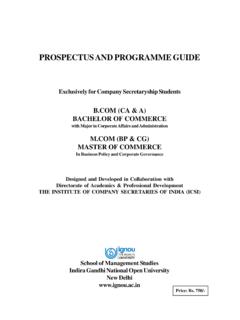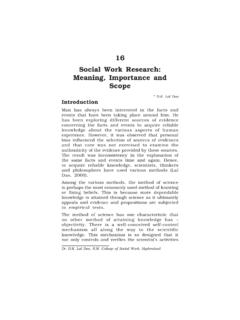Transcription of UNIT 5 DESIGN OF SCREWS, FASTENERS Design of Screws, …
1 105 DESIGN of Screws, FASTENERS and Power Screws UNIT 5 DESIGN OF SCREWS, FASTENERS AND POWER SCREWS Structure Introduction Objectives Geometry of thread Mechanics of Screw and Nut Pair Power Screw Mechanics Application of Power Screw Standard Threads DESIGN of Screw and Nut Threaded Fastener Failure of Bolts and Screws Permissible Stresses in Bolts Summary Key Words Answers to SAQs INTRODUCTION Screws are used for power transmission or transmission of force. A screw is a cylinder on whose surface helical projection is created in form of thread . The thread will have specified width and depth, which bear some ratio with the diameter of the cylinder. The screw rotates in a nut, which has corresponding helical groove on the internal surface. Thus a nut and a screw make a connected pair in which one remains stationary while other rotates and translates axially. The helical surface of the screw thread makes surface contact with the helical groove surface of the nut.
2 If an axial force acts on, say screw moving inside stationary nut, the point of application of the force will move as the screw advances in axial direction. This will result in work being done and hence power being transmitted. Both types one in which screw rotates and advances in a stationary nut or one in which screw rotates between fixed support and nut is free to move axially are used in practice. In the latter case the force acting on nut will move as nut translates. However, the friction between the surfaces of contact will require some power to be overcome. Hence the power delivered by the screw-nut pair will be less than the power supplied. The contact surfaces of screw thread and nut groove are made perpendicular to the outside and inside cylindrical surfaces. They are sometimes given a small inclination. Such provision keeps coefficient of friction to a reasonable low level. The coefficient of friction may be further reduced by lubrication. However, by creating considerably inclined surfaces in nut and screw the effective coefficient of friction is increased.
3 Such screw thread joint will make advancing of threaded part difficult. This combination will be used as fastening device. Objectives After studying this unit, you should be able to describe geometry of screw and nut, define mechanics of screw and nut, 106 Machine DESIGN determine forces on screw and nut threads, calculate dimensions of screw and nut for transmission of force, and find the force on screw fastener and load transmitted to parts jointed by FASTENERS . GEOMETRY OF thread Look at Figures (a) and (b) and you will get a fair idea how would a screw and a nut appear. The screw will pass into nut by rotating either of them. For understanding how a helical thread can be formed on a cylinder you can take a plane sheet of paper and draw an inclined line on it. Then roll the paper to form a cylinder by bringing two opposite edges of the paper together. The line which you drew will appear like a helix on the surface of the cylinder. A line drawn as AC, inclined at angle with horizontal line AA1, will be wrapped on the cylinder to AA , looking like a helix.
4 AA1, becomes the circumference of the cylinder and A coincides with C. In Figure , you can see two parallel lines AC and A C drawn inclined at to horizontal and then paper wrapped to form a cylinder and thus two threads are formed on cylinder. p is the vertical distance between A and C or between C and C . If the paper is wrapped such that the lines drawn are on the inside surface, you can get the idea of internal thread . dP/2p/2pd1 DoD (a) A Screw (b) A Nut Figure : Screw and Nut with Helical Surfaces Cut on Outside and Inside Surfaces of Cylinders, respectively C CPdA A C C dA1A Figure : Formation of a Helix on the Cylindrical Surface The distance A1C which is equal to AA and A C is called the pitch of the screw. Pitch is apparently the distance between two corresponding points on two consecutive threads. The angle between the base of the triangle and hypotenuse becomes the angle of helix. Obviously, 107 DESIGN of Screws, FASTENERS and Power Screws tanpd or tanpd.
5 ( ) If the helix on the outside surface ascends from right to left the thread is left hand. Such a threaded screw will have to be turned counter clockwise to engage the mating nut. On the other hand a right hand screw will be turned clockwise and its helix will appear to ascend from left to right. The thread shown in Figure is left hand. If a plane figure, say a triangle or trapeziums placed in contact with the outer surface of the base cylinder on which the helical line was created and then is made to rotate round the cylinder along the helix then the helical surfaces will be formed on the base cylinder giving rise to thread as can be seen in Figure If the generating plane section is a square, a square thread is created. The thread depicted in Figure (a) is a square thread . The Vee thread is created by a triangular section while trapezoidal thread has a trapezium section. This thread is also known as the Acme thread . Buttress thread has a triangular section but one side of the triangle is perpendicular to the axis.
6 The square, the Acme and the buttress threads are used for power transmission, as they are more efficient than the Vee thread . The square thread is most efficient but difficult to produce and hence becomes costly. The adjustment for wear in square thread is very difficult but can be easily achieved in the Acme threads, by splitting the nut along the axis. The Acme threads thus can be used as power transmission element when power is to be transmitted in both the directions. Bose cylinderGenerating rectangleThreadHelix created in Figure Figure : Generating a Square Section thread on Cylindrical Surface There is little or no backlash in the Acme threads which are commonly used as feed and lead screws of machine tools. The buttress thread having one side flat and other sloping combines the advantage of square thread and Acme thread . The flat side provides the efficiency of power transmission while the inclined side provides the ease of adjustment. However, these advantages become possible only when the power is transmitted in one direction.
7 Vee threads for their lower efficiency for power transmission are used as FASTENERS . Due to sides being inclined the effective coefficient of friction between the screw and the nut increases. Figure shows Vee or triangular, the Acme and the buttress threads with leading nomenclature. The major diameter is the largest diameter of the screw thread denoted by d for external thread and by D for internal thread . Minor diameter (d1 or D1) is the smallest diameter of the screw. Some times more than one thread may be cut on the screw. These multiple threads may be easily seen at the end of the screw where more than one thread will appear to start. Multiple start threads give the advantage that screw can move through a longer distance in the nut when given one rotation as compared to the screw with a single thread or start. The distance moved by a screw along its axis when given one rotation is called the lead. Apparently lead = number of starts pitch .. ( ) 108 Machine DESIGN ddmThreadangle CrestRoot45oPVee Thread45od1 (a) Vee thread + (b) Acme thread (C) Buttress thread (c) Buttress thread Figure The V-threads are standardized by several organizations wherein nominal major diameter, pitch and pitch diameters are described.
8 according to IS : 1362-1962 a screw thread (VEE type) is designated by letter M followed by nominal major diameter. An M thread has nominal major diameter of mm. IS : 4694-1968 describes basic dimensions of square threads. MECHANICS OF SCREW AND NUT PAIR It was mentioned earlier that the motion between nut and screw is like a body moving on an inclined plane. Figures (a) and (b) will explain this motion. The body of weight W is pushed up the inclined plane by a force P which acts upon the body horizontally. This inclined plane is bent round a cylinder in Figure (b) and aome body is being pushed up the plane while force P remains horizontal but also tangential to circular path of the body. This illustrates how the motion of the nut on the thread is similar to motion of a body on an inclined plane. The weight of the body on the inclined plane is replaced by weight carried by the nut in axial direction. The force P is applied by the help of a wrench and W may be the reaction developed between surfaces of contact.
9 109 DESIGN of Screws, FASTENERS and Power Screws NWFP (a) Inclined Plane rWThreadBasecylinder (b) Inclined Plane Wrapped Round a Base Cylinder to Form a thread Figure This is illustrated in Figures (a) and (b). Imagine that a lever is pivoted on the axis of the cylinder and pushes the body of weight W up the incline of helically wrapped plane on the cylinder. The lever touches the body at a radius r while a force P1 is applied on the lever at an arm length of L. In the nomenclature we have already defined the outer diameter of the thread as major diameter, d and the smallest diameter as the diameter of the cylinder, d1, (also called core diameter). r is 2dm where dm is the mean diameter of thread , being mean of d and d1. If P be the force applied by the lever on the body of weight W, then by taking moments of forces, acting upon the lever, about the axis of the cylinder. 12mPLPd .. ( ) MP1 NutCoads add upto WThreadsWrench (a) dm/2 LPWP1 FN (b) Figure 110 Machine DESIGN The force P has to overcome the friction as well as cause lifting of the body in vertical direction.
10 To find the relationship between force P, called effort, and weight of the body, W, we have to consider the equilibrium of the body on an inclined plane as shown in Figures (a) and (b). The free body diagram clearly shows forces along and perpendicular to the inclined plane. NW P CosP SinW SinPCosWN (a) A Body being Pushed Up the Inclined Plane with Angle of Inclination a, by a Horizontal Force P SinPcosWN CosP SinW (b) Free Body Diagram of Body of Weight w Figure The sum of the forces perpendicular to the plane and sum of the forces along the plane should separately be zero to satisfy the conditions of equilibrium. is taken as coefficient of friction between the body and the plane, which is same as coefficient of friction between the nut and screw thread surfaces. = tan where is the angle of friction. Summing up the forces perpendicular to the plane. The normal reaction, N = W cos + P sin Hence, force of friction between the surfaces of contact cossinFNWP Summing up the forces parallel to the inclined plane cossincossin PWWP.
